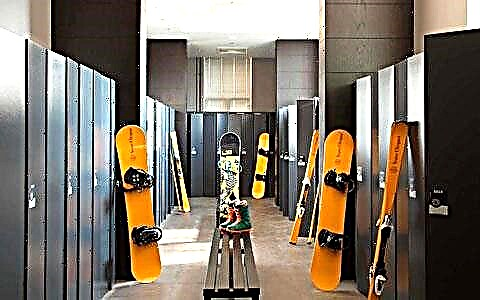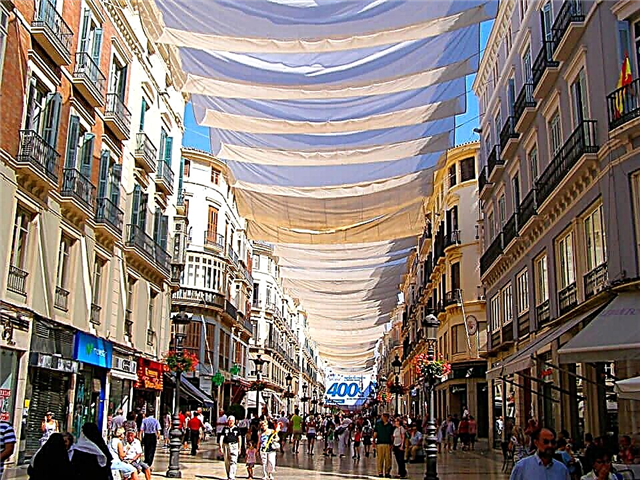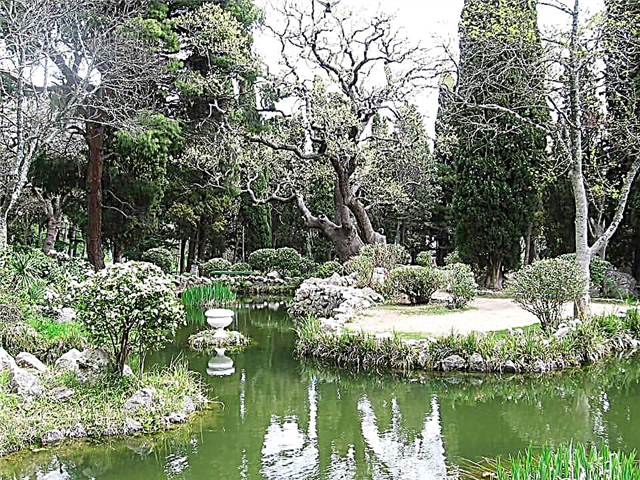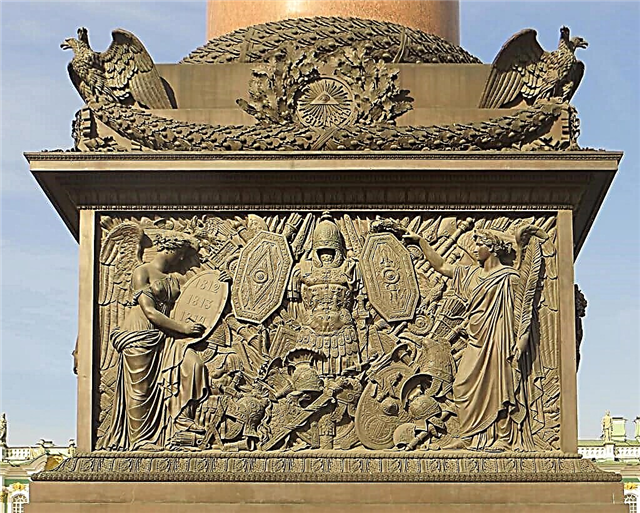One of the tallest (among the famous columns of the planet), a city landmark built of beautiful, rare granite, rises on the Palace (main) square in its central part. The Alexander Column in St. Petersburg deservedly attracts special attention of tourists and local residents.
History

The architectural landmark is a monument dedicated to the glory and courage of the Russian people under the leadership of Emperor Alexander I in the momentous overthrow of Napoleon. The majestic creation harmoniously complements a single architectural ensemble. It continues the historical version of the triumphal buildings that were born in ancient times and adorn the squares of many countries (Troyan's columns in Rome, Nelson's in London).
The main difference and dignity of the Russian Column is the beauty of the monolithic stone used in the form of a single piece of beautiful granite. It is almost 10 m higher than its original source: the Trojan Monument in Rome (the Vendome Column of Paris). The initial stage of the construction of the column provided for a serious design competition, detailed discussion of each element. They all have their own interesting history of creation.
Two variants of the Montferrand project
The attraction is a masterpiece of labor, engineering, artistic creativity of Auguste Montferrand. The main requirements presented to the architecture at the beginning of the project were: the monument should serve as a landmark and surpass in height (all existing at that time) similar structures. The first version of the monument looked like an obelisk. On the front side of the surface (height 25, 6), it was supposed to place paintings, bas-reliefs from the moments of the war. The complex pedestal was planned to be decorated with a sculpture of a rider who defeated a snake. There is a two-headed eagle in front of the rider. The goddess of Victory walks behind the figure. It was also supposed to place the line “Blessed - grateful Russia” here. The project was rejected by Nicholas I. Now it is kept in the library's repository. The second version of the project was approved by the Emperor in 1829.
Final project

After rejecting the first version of the monument, the emperor pointed out the concrete shape of the monument, reminiscent of ancient columns. The images of three columns were chosen as the basis for the final design of the monument: Trajan and Anthony (Rome), Pompeii (Alexandria), and the Vendôme column of Paris. The architect did not plan to use complex elements of decoration of the column (bas-reliefs, entwining the entire height of the column). It was a variant of a simple pillar, fixed on a special pedestal (a copy from Troyan's column), decorated with a top. The planned height should be about 48 m, which is higher than single, monolithic buildings. In 1829, the proposal (without the final development of the sculptural design) was accepted by the emperor. The main idea was to create a magnificent monument from a single piece of stone. Montferrand was approved as the builder. Litta (chairman of the commission for the construction of St. Isaac's Cathedral) was responsible for the installation of the monument.
Extraction of stone

As a building material, they used granite, mined in the Puterlak quarry (now this territory belongs to Finland). Previously, elements of St. Isaac's Cathedral were carved on this site (the weight of its columns was about 114 tons). The rock work was supervised by a young master (20 years old self-taught) Vasily Yakovlev. Their rocks of red granite cut down a huge prism, cleared of soil, moss, and laid them on a litter of spruce legs. To overturn the prism (from the rock onto the litter), complex levers and other devices were used. The required dimensions were made, the column was processed here, at the cutting site.
For the delivery of heavy cargo, a special ship "Saint Nicholas" was built according to the project of engineer Glasin. The ship with a cargo of 600 tons was towed by two steamers. The stones of the foundation of the monument were cut out of the same rock and also delivered to the city (the weight of individual stones was 400 tons). They were brought to the city first. An accident occurred during the transportation of the column. The pier could not support such a weight. The column fell into the water. About 600 strong soldiers were able to pick it up and complete the delivery.
Pedestal construction
Before installation, 1,250 pine piles were driven into the ground. Their length is 6 m. A box with special commemorative money (coins) issued as a sign of victory over Napoleon was placed in the center. A massive monolithic pedestal was installed with rollers moving on an inclined surface on an original platform. They brought it to the desired site, threw it onto a prepared pile of sand. The surroundings shuddered from the blow, frightening passers-by with a powerful blow. After fixing the special supports, the sand was removed, and rollers were installed in its place.
Having destroyed the props, the block was moved to the rollers. With their help, it was installed on the foundation. With the help of steel ropes, the stone was raised to a height of one meter. The rollers were removed, a kind of (slippery) solution was poured. It consisted of vodka, cement, soap. Thanks to the soapy additive, it was possible to precisely set the monolith due to repeated movements. The upper steps of the pedestal were smaller. The processed granite parts were fastened with steel brackets, installed on the prepared cement composition. In 1832, an important element of the monument was ready for further work.
Installation

To lift a heavy pillar onto a pedestal, they used special devices, by analogy with the systems used in the construction of St. Isaac's Cathedral. Huge forests, thousands of soldiers' hands, several hundred workers were involved in the rise. The lifting mechanism consisted of scaffolding (47 m high), 60 powerful capstans installed over the entire area, a block system at the top and bottom of the monument. To mark the base of the pillar, a temporary brick massif 10 m high was built. Next to the scaffolding there was a special platform, to which a monolith was brought up along rollers, an inclined surface.
Numerous ropes were wound along the entire length, going to the block systems, capstans. At the appointed time, the column rose, moved calmly, broke away from the soil, rose to the calculated height, determined by the calculated position in the pedestal. On command, the movement of the column ended. She got to the required place in just 1 hour and 45 minutes. The emperor watched the ascent, a huge number of ordinary people. "Hurray" sounded over the city. At first, the columns, held by their own weight, were wary and walked carefully. To relieve tension in society, the architect began to regularly walk next to his creation.
Opening of the monument

Two more years after the installation of the column passed until the day of the grand opening. It was necessary to decorate the structure with bas-relief slabs, to make the final polishing of the rod. Finish the construction of the amazing Column Top. For the convenient movement of troops across the square, together with the construction of the monument, the Pevchesky (Yellow) Bridge over the Moika River was erected (Montferrand's version). After that, the opening ceremony of the monument was scheduled (for August 30, 1834). A hundred thousandth army marched across the new bridge to the site of the opening of the monument. Members of the imperial family, diplomats, generals of the Russian army attended the grand opening of the monument, which became a harmonious decoration of the main square.
Description
If you look from some windows of the Winter Palace, then the gaze freezes in admiration at the sight of the majestic pair of the arch of the General Staff, the Alexander Column.The pink giant, created by Montferrand in the likeness of existing antique columns, has an important difference: a fundamentally different approach to the principles of the thinning of the rod, influencing the integral perception of the architectural structure.
Unlike ancient designs, the formation of the column line began not from the third part of the height (the classic version of the calculation), but from the base. The thinning curve was calculated according to more complex mathematical laws using more approximations (divisions). The diameter of the base of the monument had dimensions similar to those of Troyan's column. An important element of the structure is the Doric capital, built of bronze at the top of the rod.
It is attached to an abacus (rectangular shape) made of bricks with bronze plating. The main support of the array is hidden in the upper part (in the form of a semi-ball). It is made of many layers: granite, quality brick masonry, two layers of granite. Thanks to the ideas of the architect, the tall, reliable column does not look like a massive block, but like a slender arrow triumphantly directed high into the sky.
Characteristics
The total height of the column is 47.5 m.The main parts of the monument have the following parameters:
- The pedestal, consisting of three rows of 8 stone blocks, has a height of 4.25 m. The weight of a monument element with a plinth is 704 tons. The dimensions of the basement are 6.3 × 6.3 m.
- The monolithic part of the column has a height of 25.6 m, the lower diameter is 3.66 m, and the upper diameter is 3.15. The barrel weight is 812 tons.
- The top in the shape of an angel is 4, 26 m high and weighs 37 tons. The height of the column (with the cross) is 12 m.The cross itself is 6.4 m high.
- The dimensions of the bordering fence are 16.5 × 16.5 × 1.5 m
- The bas-reliefs are 5.24 × 3.1 m.
Pedestal

Montferrand made sketches for the decoration elements of the pedestal and bronze decorations. The thematic direction corresponded to the purpose of the column in glorifying the victory of the Russian army, types of weapons. Among them are old Russian chain mail, helmets, shields, armor. They are made in full analogy with the originals that are among the exhibits of the Armory.
The style of execution of the bas-reliefs most closely matches the techniques of the Renaissance. The elements were pre-made from natural-sized cardboard. On the north side of the pedestal there are figures of winged women holding a plate with the inscription "Alexander I grateful Russia" exact copies of military armor. On both sides of the elements with weapons, there are figures of a young girl, an Aquarius. Water flows out of the urn next to the girl, depicting the symbol of the Neman, Vistula rivers, where the battles took place.
On separate bas-reliefs the dates of important victories are recorded, allegories such as "Victory and Peace" are presented, and others. The upper part of the pedestal is decorated with figures of two-headed eagles with an oak garland clutched by their paws. All elements of the pedestal symbolize courage, the victory of Russian soldiers in the war of 1812.
Column, sculpture of an angel

The vertical line of the monument, the slenderness of the majestic structure is completed by the figure of an angel with a cross. The figure resembles Alexander I, standing with his right hand outstretched, holding a cross in his left hand and trampling a snake. The winged angel's gaze is directed towards the earth. He, as if, dominates the order, tranquility of the inhabitants of the amazing city. The sculpture is considered a symbol of peace and tranquility in Europe after the victory over Napoleon's army. The figure was fastened at the expense of a special rod (an angel leaned on it). During the 2003 restoration, it was removed. Now the angel (like a column) is held by its own weight.
The fence, the surroundings of the monument
The panoramic view of the monument from all sides is completed by an interesting fence, erected at the suggestion of Montferrand. All elements of the fence were assembled in 1837. In the initial version of the building, a guard bun was located in the corner of the fence. A disabled person, dressed in ceremonial clothes, was on duty here. The height of the building is 1.5 m. It contains figures of 136 two-headed birds, 12 cannons, rows of spears, flagpoles with two-headed eagles. Symbolic locks hung on the gate of the castle fence.
The project provided for the possibility of lighting the monument with lanterns, gas devices, located in candelabra. The secret of the fence is the optical illusion hidden in the figures of the eagles. They have not two heads and two wings, but three. At any angle of view, only two are visible, in accordance with the double-headed eagle symbol. The third element is visible only upon close examination of the monument.
Legends
The famous landmark of the city is covered with interesting facts, legends from her life. Local residents have long feared the majestic structure, holding on to its own weight. They also believed that:
- Omens, mystical stories are associated with the column. Foreign Minister Lamsdorf thought that a bright letter "N" appeared on the column, indicating the emergence of a new king. The answer turned out to be simple: the letter (etched by the name of the manufacturer) appeared when the lamps on the side of St. Isaac's Cathedral were turned on.
- An interesting legend is associated with the location under the column of a place with rich oil deposits. If you move the column, an unprecedented fountain of natural wealth will gush out from under the ground.
- During wedding rituals, the groom carries the bride in his arms as many times as there will be children in the family.
Where is it located and how to get there

The attraction is located in the central part of the Palace Square. Using the metro services, you need to go to the Nevsky Prospekt stop. Guided by the spire of the Admiralty, walk to the beginning of Nevsky Prospekt. A beautiful view of the main square of the city strikes the view from the junction of Nevsky and Admiralteisky avenues. Festivals, festivities, concerts, the traditional “Scarlet Sails” celebration are held next to the majestic column.
Many people walk here. Finding a landmark is easy. Near the monument, rides are organized in carriages used in the time of Peter. They are used for trips around the historic city center. Tourist buses are parked near the embankment. You can take part in numerous excursions.











